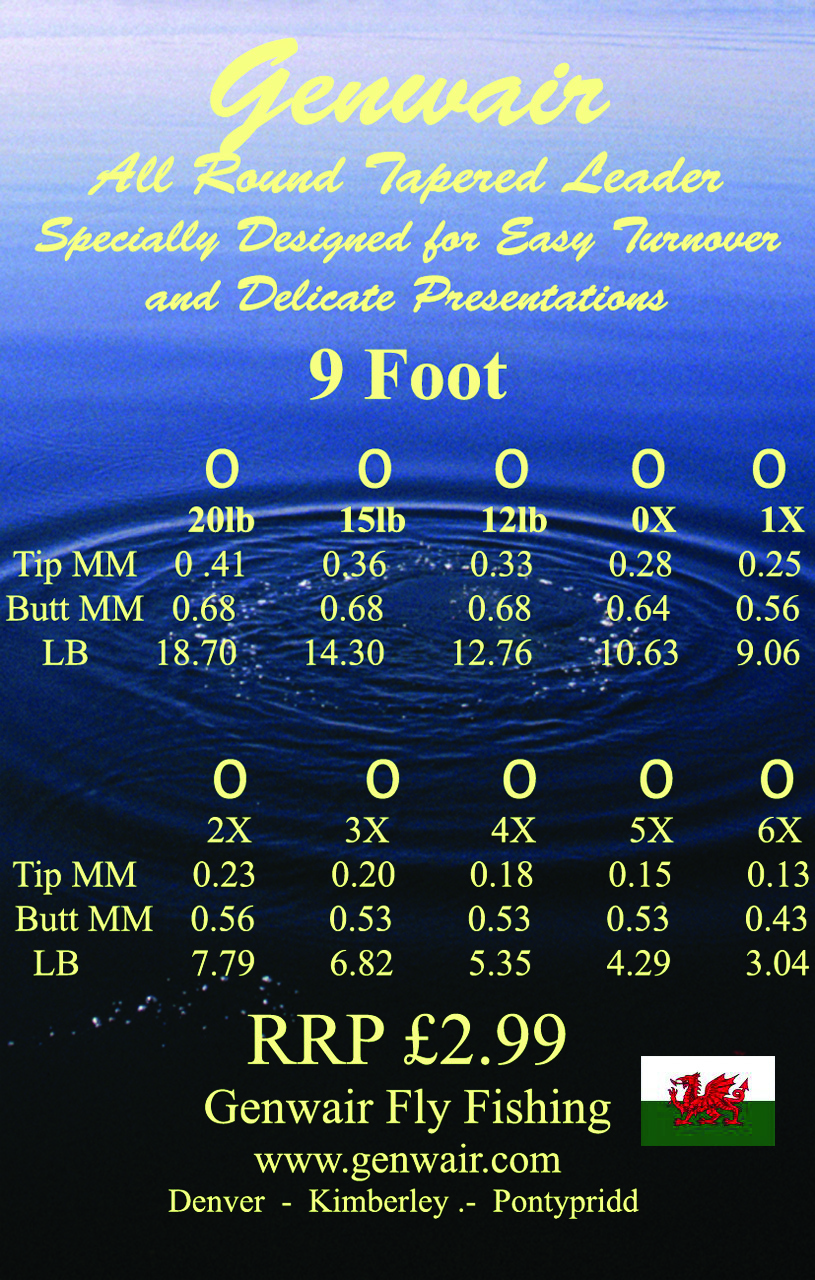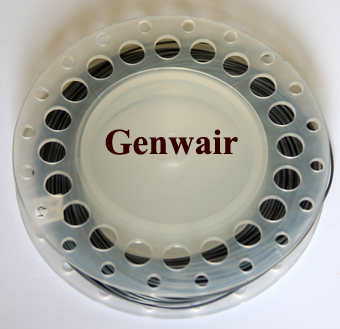|
Genwair Fly Fishing, Genwair House. Pencoed Avenue, Pontypridd, Wales CF37 4AH The Fly Line
The fly line
is crucial: having the right line
for your rod and the type of fishing
you do can make all the difference
between a pleasant day of fishing
and utter frustration.
Floating Fly Line vs. Sinking Fly Line
Fly lines are made of different
materials that perform in markedly
varying ways. They’re coded using
different letters.
Line Weight
Fly lines also vary significantly
by weight.
This table shows the American
Fishing Tackle Manufacturing
Association (AFTMA)’s measurement
system, which categorizes lines from
1 (lightest) to 12 (heaviest).
Weight measurements are rarely
exact, so the table gives a range of
acceptable weights for each
category.
Most beginning fly fishermen use
line weights of 5–7, which are very
versatile on both still water and
rivers. The lightest lines (1–4)
are used for much more subtle
presentations.
Heavier lines (8–9) are sometimes used for
choppier and windier conditions but
in truth a lighter line is far
better in these circumstances. If
you use a 7 weight rod then in windy
conditions use a 6 weight line but
let out about 40 foot or so in order
that the extra line fully loads your
rod. Keep your heavier lines for
larger flies and bass bugs. The
heaviest lines (10–12) are used for
saltwater fishing but even here many
experienced angles have discovered
that the lighter your line weight
the more chance you have of catching
fish.
Taper
The
diameter
of every
fly line
gets
narrower
toward
the
front
tip.
This
taper
dissipates
the
force of
the
fisherman’s
cast as
it
transfers
to the
leader
and fly,
which
lets the
fisherman
deliver
the fly
delicately
rather
than
just
slap it
forcefully
onto the
water.
The most
common
fly line
tapers
appear
below.
There
are many
others,
but they
are all
variations
on the
weight-forward
taper or
shooting
taper.
Weight-forward taper (WF): In this line, weight is concentrated in the forward section, so the heavy line can pull the lighter running line for extra-long casts. Double taper (DT): This line has an identical taper at each end. A double taper line is easy to cast with delicacy and also easy to roll-cast. Moreover, both ends can be used if the line is reversed, thus giving longer life to the line. However, it does not cast long distances as well as a weight-forward line. Bass taper (BT): This is a weight-forward line with a short front taper to cast large, wind-resistant bass flies. It lacks the delicacy needed for fishing dry flies. Shooting taper (ST): This line consists of a 30–40' head with a factory-spliced loop for attaching monofilament or running line. It’s useful when casting large sinking flies in rivers for salmon and steelhead, but since it doesn’t allow a delicate presentation, it isn’t recommended for other types of fishing. Level taper (L): This line is inexpensive but doesn’t provide a gradual release of force to leader and fly, and isn’t available in all line sizes, so it’s not recommended. How Fly Lines Are Labelled
Every
fly line
you see
on a
store
shelf
will
have an
alphanumeric
code on
the box.
For
example,
you
might
see
“WF6S,”
which
indicates
a
weight-forward,
6-weight,
sinking
line. Or
you
might
see a
“DT4F,”
a
double-taper,
4-weight,
floating
line.
The
first
line
might be
useful
for
fishing
large
sinking
flies,
while
the
second
might be
the
choice
for
fishing
small
floating
flies.
However,
you
always
need to
match
the
weight
of the
line to
the rod
you’ll
be using. Cost More specialized lines cost more. For instance, if you need more delicacy in casting, you’ll want a line with a longer front taper and/or a thinner profile. If you need more distance, you might want a self-lubricating line. For any line other than the most basic, expect to pay more. What Kind of Line Should You Buy?
The right line for you depends on the type of fish you plan to fish for, the type of water you plan to fish in, and the type of fly you plan to use.
To catch trout (in small to medium rivers), bass (in ponds or streams), or panfish (in any type of water): Try a WF3 - 6F fly lines. They cast flies from sizes 2–28 well and the floating line allows easy pickup as you start your back cast. To catch bass with bass bugs or streamers: Try a bass bug taper, also WF6F but with a short front taper.
To catch northern pike, steelhead, or salmon: Get a
7 to 8-weight rod and WF7
or 8F line. These fish take large flies that cast better with the heavier line and they also require a heavier rod to fight them.
Whatever line you buy, always wind some backing on the fly reel before the line. Backing is a strong line, usually made of braided, 20- to 30-pound test Dacron® (“pound test” indicates the line’s breaking strength). The backing’s thickness increases your reel’s arbour diameter—the diameter of spool that the line winds onto (or unwinds from). This makes it quicker and easier to reel in long lengths of line and keeps your line from forming tight coils. Remember not all fly lines are the same! Mill end line is exactly that the end of a run. Cheaper lines tend to be thicker and not as slick. They are also unlikely to carry any guarantee and could in the long run cost you far more than a more expensive high quality line. At Genwair we try to provide top quality fly line at the best possible price. Genwair fly lines are covered by our 2 year guarantee.
To Reduce Environmental Impact And Save On Waste Our Lines Are Packed In Recycled Cardboard Boxes Floating Lines
Sinking Lines
Intermediate Lines
Backing Line
Tippet
|


